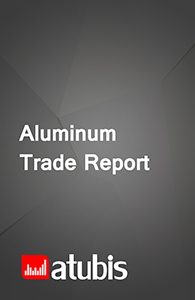Turkey’s Aluminum Sheet & Plate Market Outlook Report
475,000 ₺
- EUR: 9,821€
A major portion of aluminum sheets and plates fall in the non-heat-treatable alloy category. Series 3xxx and 5xxx alloys take the largest market share. There are also series 1xxx alloy sheets and plates, mainly used in electrical applications. Aluminum sheets and plates in Turkey are mostly produced using cold rolling. There are fewer passes in the cold rolling process, which translates into less equipment required, lower capital intensity, and lower production costs.
Packaging for chemicals and beverages, false ceilings, dampa ceilings and tiles, as well as composite panels are some of the main applications of aluminum sheets and plates. Thus, construction and packaging are the main consumers of these products in Turkey. Both industries are expected to grow over the coming years.
Product Description
With a GDP of $761 billion in 2019, Turkey was the second largest economy in the region that year, behind Saudi Arabia. The country joined the Economic Cooperation Organization in 1961 and also became a member of G20 in 1991. However, Turkey is still a developing country, according to the UN in 2019. With an annual consumption of 1.2 million tonnes of aluminum, the country is the largest consumer in the region. But there is only one primary smelter in the country, which has ramped up capacity to 82,000 tonnes since late 2015 with renovation and improvement plans. High power costs (a major part of aluminum production costs) have made primary aluminum production less attractive in Turkey.
Market drivers of aluminum sheets and plates
Easy and quick installation, heat insulation (preventing energy loss), and self-cleaning properties are some of the advantages of using composite panels. Given that this type of façade is mainly used in commercial, non-residential buildings such as hotels and shopping malls, demand for composite panels is expected to grow as non-residential construction increases in the country. Moreover, with the population growth, development of the tourism industry, and the high urbanization rate, beverage production is expected to increase, giving a boost to demand for aluminum sheets used in beverage cans.
With higher beverage consumption in Turkey along with an increase in the number of foreign tourists, the government is considering increasing the tax on these products, which will further drive beverage prices. This can put pressure on beverage demand and, consequently, demand for aluminum sheets used in beverage cans will also be affected.
Overview of Turkey’s aluminum sheet and plate market
About a third of total aluminum consumption in Turkey goes to the production of flat aluminum products, with sheets and plates taking the largest share in the country’s total flat products. Trade balance has been generally positive over the years and the country has been a net exporter. Between 2015 and 2019, net exports averaged 51,800 tonnes per year. This proves the undeniable share of imports in Turkey’s sheets and plates market. Major suppliers were Germany and China; until 2018, Germany was in the lead, but then China took the crown. The US-China trade war and the cumbersome tariffs levied by the US on Chinese flat products changed the flow of Chinese products from the US to other countries; Turkey was one of the alternative destinations for Chinese producers. At the same time, Turkey’s exports to the US increased significantly, which indicates that Chinese products might have been re-exported with Turkish brands to the US through Turkey. Taking this into account, and also considering that the US-China tensions are expected to subside, Turkey’s role as a trade channel is likely to fade, but it will create opportunities for Turkish producers to continue their presence in the market. Thus, Turkey’s trade balance is expected to remain in positive territory and net exports will continue to grow, albeit at a slower rate.
Breakdown of Turkey’s aluminum sheet and plate market
Domestic demand for aluminum sheet and plate in the forecast timeframe as well as the previous period has been broken down using three factors. The first factor breaks down the market into three categories based on alloy material: commercially pure aluminum, heat-treatable alloys, and non-heat-treatable alloys. Past and future trends for each type of material have been analyzed. Non-heat-treatable alloys hold the largest share of the market. In the second breakdown, products are divided into two categories based on thickness: sheets (0.2mm to 6.0mm) and plates (more than 6.0mm), with sheets taking a major share of the market. Finally, using the third factor, aluminum sheets and plates are categorized based on their applications in different industries. The packaging industry and the construction sector are the largest consumers of aluminum sheets and plates in Turkey.
Key players in Turkey’s aluminum sheet and plate market
- Astaş Aluminium
- Metal Profil Alüminyum San. Tic. A.Ş.
- Boen Aluminyum Metal Yapi
- Almetal Alüminyum Sanayi Ticaret A.Ş.
- Okyanus Alüminyum Sanayi ve Ticaret A.Ş.
- Tuna Alüminyum
- ASAŞ
Additional Information
| Industry | Aluminium Flats |
|---|---|
| Region | Turkey |
| Report Type | Industry Report |
Specifications
| Report Attribute | Details |
| The base year for estimation | 2019 |
| Historical data | 2009-2018 |
| Forecast period | 2020-2025 |
| Quantitative units | Value in USD and Volume in Tonne |
| Report coverage | Market Overview, Dynamics, Market Outlook, Risks to Forecast, Consumer Market, Industry Overview, Market Landscape, Competitive Landscape, Market Attractiveness, External Macro Environment Analysis |
| Segments covered | Composition, Type, Application |
| Pricing and purchase options | Please explore our purchase options to meet your exact research needs. |
Reasons to Buy
- Recognize the geographical distribution of import demand
- Identify the current and future key players of the trading market
- Achieve a better insight on potential target markets
- Understand the behavior of major suppliers/customers either globally or regionally
- Identify competitors as a feed for market analysis
Table of Content
- Executive summary
- Introduction
- Objective
- Market under study
- Product
- Product specifications
- Consumption structure
- Applications
- Physical properties
- Subjects discussed
- Geographical scope under study
- Study timeframe
- Study currency
- Potential audience
- Market dynamics
- Market drivers
- Restraints
- Opportunities
- Challenges
- Market overview
- Market size
- Industry capacities
- Existing capacities
- Capacity distribution
- Geographical distribution of capacities
- Future capacities
- Existing capacities
- Output
- Output trends
- Operating rates
- Consumption
- Consumption trend
- Consumption Share of domestic product
- Trade
- Exports
- Imports
- Trade balance
- Market balance
- Market breakdown by product type
- Market breakdown by product type
- Market breakdown by application
- Inventory
- Producers inventory
- Consumers inventory
- Traders inventory
- Market outlook
- Market factors
- Raw materials
- Costs and prices
- Competition
- The government
- Other factors
- Future scenarios
- Risks to forecast
- Market factors
- Consumer markets
- End-user markets
- Building construction
- Infrastructure construction
- Transportation manufacturing
- Industrial equipment manufacturing
- Durable goods manufacturing
- Consumable goods manufacturing
- Direct consumer markets
- Major Direct consumers
- Existing capacities
- Drivers
- Major Direct consumers
- End-user markets
- Export potentials
- Destinations
- Trade and insurance costs
- Import market suppliers
- Producers potential share
- Destinations
- Industry overview
- Raw materials
- The supply volume of raw materials
- Supply channels of raw materials
- Raw materials procurement costs
- Cost structure of producers
- Production cost curve
- Industry value added
- Generated new scrap
- Technology
- Raw materials
- Market landscape
- Domestic sales markets
- Pricing in the domestic market
- Potential domestic demand
- Trade agreements for imports
- Foreign suppliers
- Foreign sales market
- Prices
- Potential markets overview
- Trade agreements for exports
- Foreign customers
- Domestic sales markets
- Competitive landscape
- Producers
- Company profile
- Revenue structure
- Gross profit margins
- Capacity, output and sales
- Consumers
- Company profile
- Revenue structure
- Gross profit margins
- Capacity, output and sales
- Producers
- Market attractiveness
- Industry rivalry
- Threat of new entrants
- Threat of substitutes
- Bargaining power of buyers
- Bargaining power of suppliers
- Conclusion of Porter analysis
- PESTEL analysis
- Political factors
- Economic factors
- Social factors
- Technology factors
- Environmental factors
- Legal factors
- SWOT analysis
- Large-scale companies with favorable conditions
- Short-term strategies
- Long-term strategies
- Large-scale companies with unfavorable conditions
- Short-term strategies
- Long-term strategies
- Small enterprises with favorable conditions
- Short-term strategies
- Long-term strategies
- Small enterprises with unfavorable conditions
- Short-term strategies
- Long-term strategies
- Large-scale companies with favorable conditions
List of Figures
- Output and consumption; 2010-2019
- Market share of product applications; 2019
- Market surplus; 2019-2025
- Production process flowchart
- Market size; 2010-2025
- Existing capacity; 2010-2019
- Capacity distribution; 2019
- Geographic distribution of capacities; 2019
- Development of future capacity; 2010-2025
- Amount of output; 2010-2025
- Operating rates of production plants; 2010-2025
- Amount of consumption; 2010-2025
- Consumption share of domestic product; 2010-2025
- Exports of product; 2010-2019
- Imports of product; 2010-2019
- Historical trade balance; 2010-2019
- Future Market balance; 2021-2025
- Market output breakdown by alloy type; 2010-2025
- Market consumption breakdown by alloy type; 2010-2025
- Market balance breakdown by alloy type; 2010-2025
- Market output breakdown by product type; 2010-2025
- Market consumption breakdown by product type; 2010-2025
- Market balance breakdown by product type; 2010-2025
- Market consumption breakdown by application; 2010-2025
- Inventories of raw materials and products at producers factories; 2010-2019
- Consumers’ inventory of product; 2010-2019
- Traders’ inventory; 2010-2019
- Production forecast, according to raw materials and sales analysis; 2019-2025
- Market surplus; 2019-2025
- The share of end-user industries in the consumption; 2010 and 2019
- Changes in the end-consumption of extrusion products; 2019 vs 2025
- Applications in building construction industry; 2019
- Applications in infrastructure construction industry; 2019
- Applications in transportation manufacturing industry; 2019
- Applications in industrial equipment manufacturing industry; 2019
- Applications in durable goods manufacturing industry; 2019
- Applications in consumable goods manufacturing industry; 2019
- Capacity distribution structure of direct consumers; 2019
- Existing capacities of direct consumers in each province; 2019
- Suppliers of the export potential destination; 2019
- Historical exports to the export potential destination and future potential; 2016-2025
- Up-stream domestic supply; 2010-2019
- Raw materials domestic supply; 2010-2019
- Supply channels of producer plants
- Spot price of raw material in the market; 2010-2025
- Cash cost structure for production the product; 2019
- Production cost curve of the plants; 2019
- Gross value added of the industry; 2010-2019
- Generated new scrap; 2010-2019
- Sales channels
- Realized price of the product in the market; 2010-2025
- Potential demand of each province; 2019
- The main foreign suppliers to the market; 2010-2019
- FOB price vs domestic market; 2010-2025
- Map of global major importers > 20,000t; 2019
- Major foreign customers; 2010-2019
- Revenue structure of the producers; FY2019
- Sales income and gross profit margin of the producers; FY2010-2019
- Output and sales of the producers; FY2010-2019
- Revenue structure of the consumers; FY2019
- Sales income and gross profit margin of the consumers; FY2010-2019
- Output and sales of the consumers; FY2010-2019
- SWOT matrix for large-scale companies with favorable conditions
- Strategies positioning for large-scale companies with favorable conditions
- SWOT matrix for large-scale companies with unfavorable conditions
- Strategies positioning for large-scale companies with unfavorable conditions
- SWOT matrix for small enterprises with favorable conditions
- Strategies positioning for small enterprises with favorable conditions
- SWOT matrix for small enterprises with unfavorable conditions
- Strategies positioning for small enterprises with unfavorable conditions



